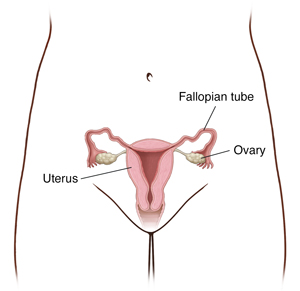Understanding Laparoscopic Surgery for Ovarian Torsion
This surgery fixes an ovary that has twisted. When such twisting happens, it’s called ovarian torsion. A fallopian tube may also sometimes twist with the ovary.
You have two ovaries. There is one on each side of your uterus. The ovaries store your eggs (ova). They also make the hormone estrogen. The fallopian tubes link the ovaries to the uterus. They carry the ova to the uterus.
Torsion can happen to a healthy ovary. But it most often occurs when an ovary has a cyst or tumor on it. The mass can cause the ovary to twist. Blood flow to the ovary may then be cut off, so it's very important that surgery be done as quickly as possible to restore blood flow. Lack of blood flow for some time can kill the ovary. Your surgeon will look at the ovary during surgery to find out if the ovary tissue has died because of the lack of blood flow.

Why laparoscopic ovarian torsion surgery is done
You may need this surgery if one of your ovaries has twisted. This surgery helps restore blood flow to the ovary.
How laparoscopic ovarian torsion surgery is done
This surgery is done in a hospital. You may need to spend a few days in the hospital to heal. During the procedure:
-
You are given medicine to make you fall asleep. You won’t feel any pain.
-
The surgeon makes small cuts in your belly (abdomen) to reach your reproductive organs.
-
The surgeon inserts a tube with a light on it (laparoscope). It helps the surgeon see inside your body. The surgeon will look at the ovary to see if it needs to be removed or if it can be untwisted.
-
The surgeon then puts in small tools that help to untwist the ovary.
-
The surgeon may remove what caused the twisting, such as a cyst.
-
The surgeon checks that blood flow has been restored to the ovary.
-
The surgeon removes all tools and closes up the cuts in your belly.
Risks of laparoscopic ovarian torsion surgery
Online Medical Reviewer:
Donna Freeborn PhD CNM FNP
Online Medical Reviewer:
Heather M Trevino BSN RNC
Online Medical Reviewer:
Irina Burd MD PhD
Date Last Reviewed:
12/1/2022
© 2000-2025 The StayWell Company, LLC. All rights reserved. This information is not intended as a substitute for professional medical care. Always follow your healthcare professional's instructions.